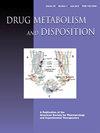Functional characterizationof RFC and PCFT for antifolates accumulation in non-small cell lung cancer cells
IF 4.4
3区 医学
Q1 PHARMACOLOGY & PHARMACY
引用次数: 0
Abstract
Antifolates are important for chemotherapy in non-small cell lung cancer (NSCLC). They mainly rely on reduced folate carrier (RFC) and proton-coupled folate transporter (PCFT) to enter cells. PCFT is supposed to be the dominant transporter of the two in tumors as it operates optimally at acidic pH and has limited transport activity at physiological pH, whereas RFC operates optimally at neutral pH. In this study, we found RFC showed a slightly pH-dependent uptake of antifolates, with similar affinity values at pH 7.4 and 6.5. PCFT showed a highly pH-dependent uptake of antifolates with an optimum pH of 6.0 for pemetrexed and 5.5 for methotrexate. The Km value of PCFT for pemetrexed at pH 7.4 was more than 10 times higher than that at pH 6.5. Interestingly, we found antifolate accumulations mediated by PCFT at acidic pH were significantly affected by the efflux transporter, breast cancer resistance protein (BCRP). The highest pemetrexed concentration was observed at pH 7.0 - 7.4 after a 60-minute accumulation in PCFT-expressing cells, which was further evidenced by the cytotoxicity of pemetrexed, with the IC50 value of pemetrexed at pH 7.4 being one-third of that at pH 6.5. In addition, the in vivo study indicated increasing PCFT and RFC expression significantly enhanced the antitumor efficacy of pemetrexed despite the high expression of BCRP. These results suggest that both RFC and PCFT are important for antifolates accumulation in NSCLC, although there is an acidic microenvironment and high BCRP expression in tumors.RFC 和 PCFT 在非小细胞肺癌细胞中积累抗磷酸盐的功能表征
抗叶酸盐是非小细胞肺癌(NSCLC)化疗的重要药物。它们主要依靠还原型叶酸载体(RFC)和质子偶联型叶酸转运体(PCFT)进入细胞。PCFT在酸性pH条件下发挥最佳作用,在生理pH条件下的转运活性有限,而RFC在中性pH条件下发挥最佳作用,因此PCFT应该是这两种转运体在肿瘤中的主要转运体。在这项研究中,我们发现 RFC 对抗磷酸盐的吸收略微依赖 pH 值,在 pH 值为 7.4 和 6.5 时亲和力值相似。PCFT 对抗磷酸盐的吸收高度依赖于 pH 值,培美曲塞的最佳 pH 值为 6.0,甲氨蝶呤的最佳 pH 值为 5.5。PCFT 在 pH 值为 7.4 时对培美曲塞的 Km 值是 pH 值为 6.5 时的 10 倍以上。有趣的是,我们发现 PCFT 在酸性 pH 下介导的抗叶酸蓄积受到外排转运体乳腺癌抗性蛋白(BCRP)的显著影响。在 PCFT 表达细胞中蓄积 60 分钟后,培美曲塞的浓度在 pH 值为 7.0-7.4 时最高,培美曲塞的细胞毒性进一步证明了这一点,培美曲塞在 pH 值为 7.4 时的 IC50 值是 pH 值为 6.5 时的三分之一。此外,体内研究表明,尽管 BCRP 的表达量很高,但 PCFT 和 RFC 的表达量增加可显著增强培美曲塞的抗肿瘤疗效。这些结果表明,尽管肿瘤中存在酸性微环境和高表达 BCRP,但 RFC 和 PCFT 对 NSCLC 中抗磷酸盐的积累都很重要。
本文章由计算机程序翻译,如有差异,请以英文原文为准。
求助全文
约1分钟内获得全文
求助全文
来源期刊
CiteScore
6.50
自引率
12.80%
发文量
128
审稿时长
3 months
期刊介绍:
An important reference for all pharmacology and toxicology departments, DMD is also a valuable resource for medicinal chemists involved in drug design and biochemists with an interest in drug metabolism, expression of drug metabolizing enzymes, and regulation of drug metabolizing enzyme gene expression. Articles provide experimental results from in vitro and in vivo systems that bring you significant and original information on metabolism and disposition of endogenous and exogenous compounds, including pharmacologic agents and environmental chemicals.

 求助内容:
求助内容: 应助结果提醒方式:
应助结果提醒方式:


